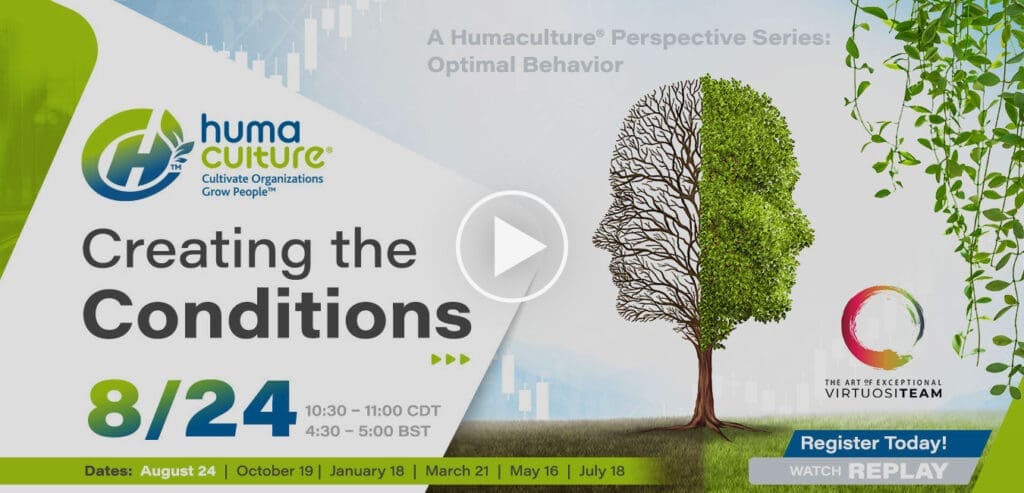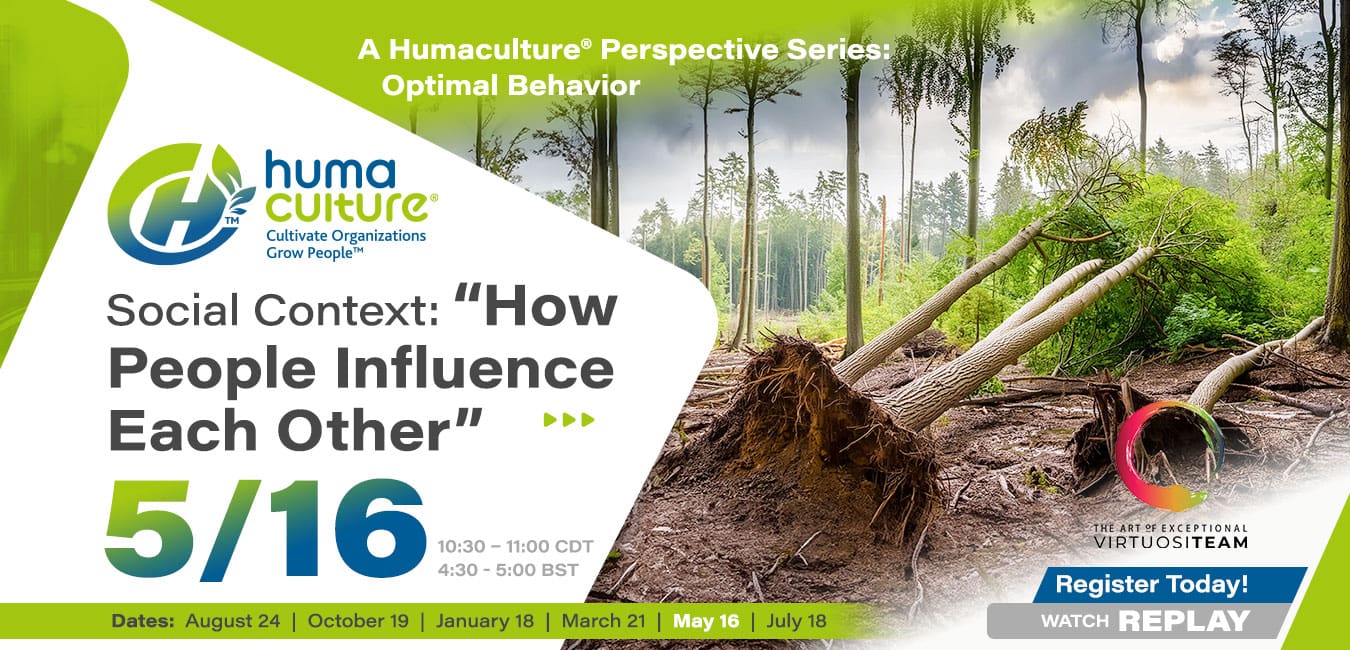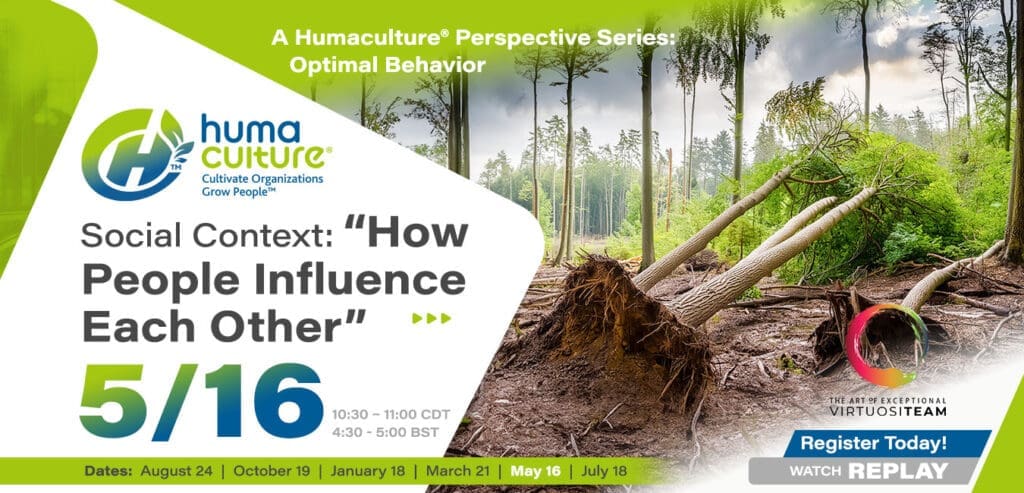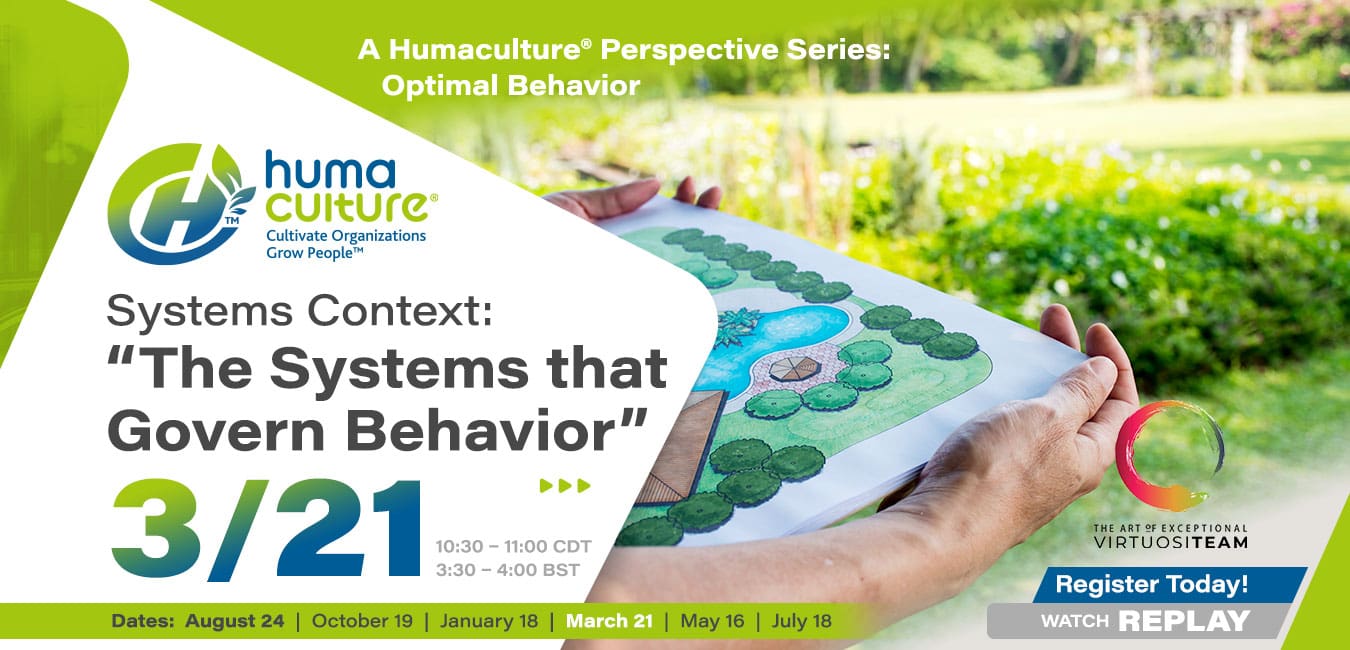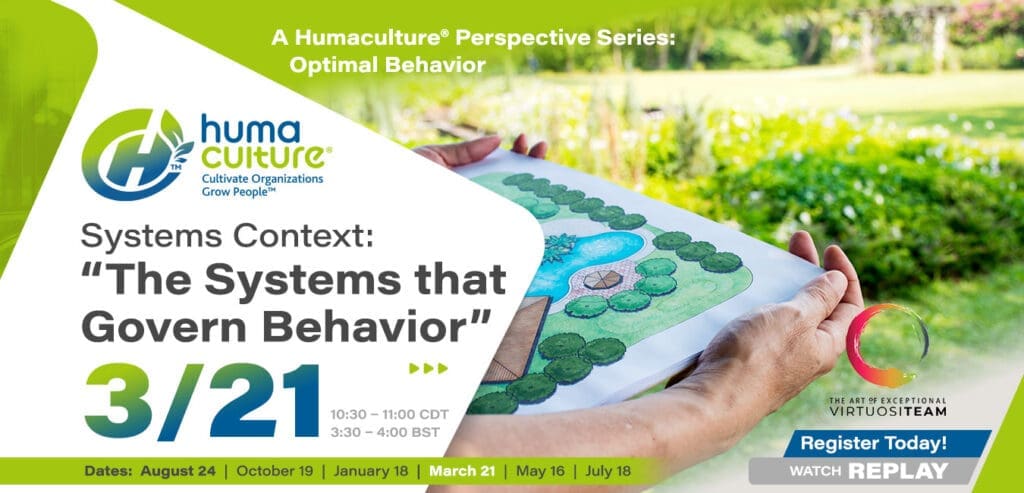Tag: optimal behavior
Webinar Replay: Harvest Time: “Reaping the Fruit of Optimal Behaviors”
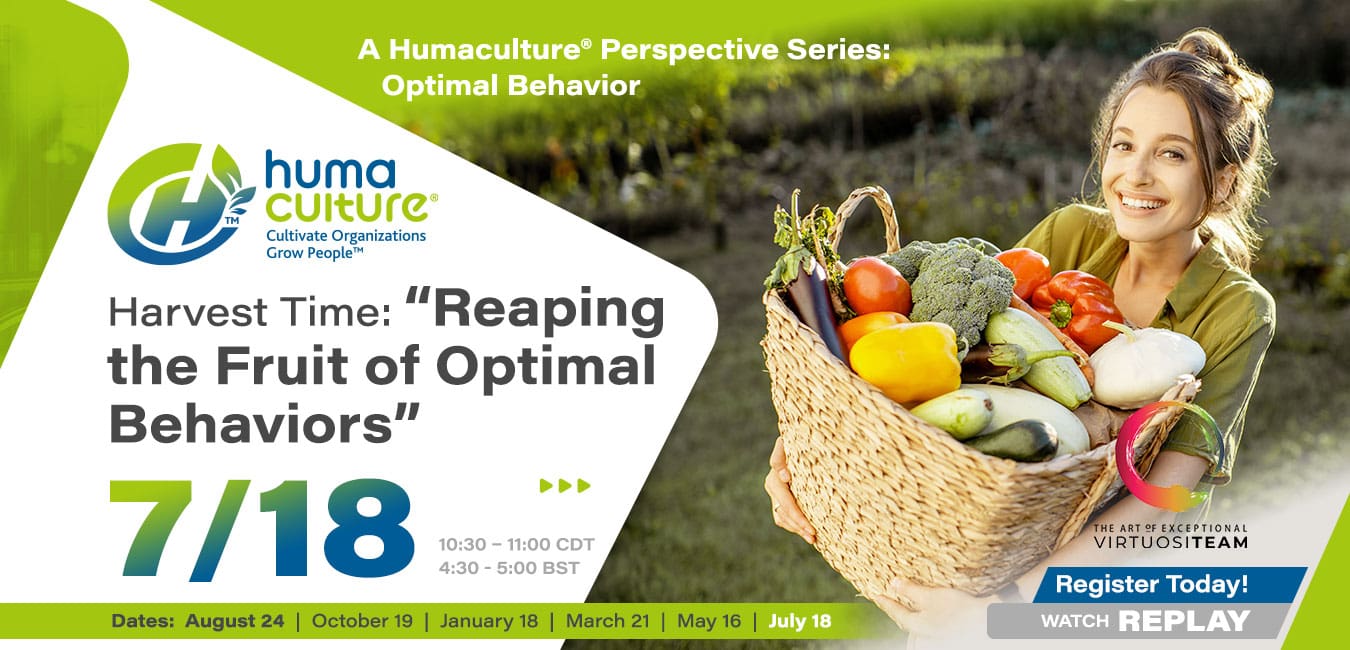
Watch a replay of the sixth and final webinar in Humaculture, Inc.’s “Optimal Behavior: Making Optimal Behavior the Natural Choice” to learn why and how to apply the four Contexts and four Powers of behavior change through a review of a case example.
Presenters
- Steve Cyboran, ASA, MAAA, FCA, CEBS, actuary and strategy consultant
- Wes Rogers, Humaculturist® and strategy consultant
- Colin Bullen, ASA, behavior change actuary
- Hanlie van Wyk, behavior change consultant
Objective
In this sixth and final session in our series on Optimal Behavior, we explore how to apply all the learning from the previous five webinars to reap a bountiful harvest produced by desired behaviors. To reliably achieve sustained Optimal Behavior, we consider all four Contexts – Spaces, Self, Systems, and Social. We do this by applying the Four Powers – the Powers to grow capability, inspire motivation, overcome barriers, and resist temptation – to align the influences acting on People toward supporting the change to Optimal Behavior. We will demonstrate the process of adjusting the Powers within the Contexts and the practical steps to take using a case study in the retail sector. We wrap up with the virtuous cycle that is the Change Ecosystem, showing how to reinforce Optimal Behaviors and ensure those behaviors stick. At the end of this webinar, attendees will understand how the Powers and Contexts come together to create the Four Powers behavior change framework and how that framework can be applied in practice.
“In the final analysis, change sticks when it becomes the way we do things around here.” – John P Kotter
Harvest Time Key Takeaways
Join us to learn how to apply the Four Powers model of change to reap the following fruits:
- Confident and capable People
- Inspired workplace
- Agile workforce
- People armored against distractions
Watch
Watch the Optimal Behavior: Harvest Time: “Reaping the Fruit of Optimal Behaviors” via Rumble or YouTube.
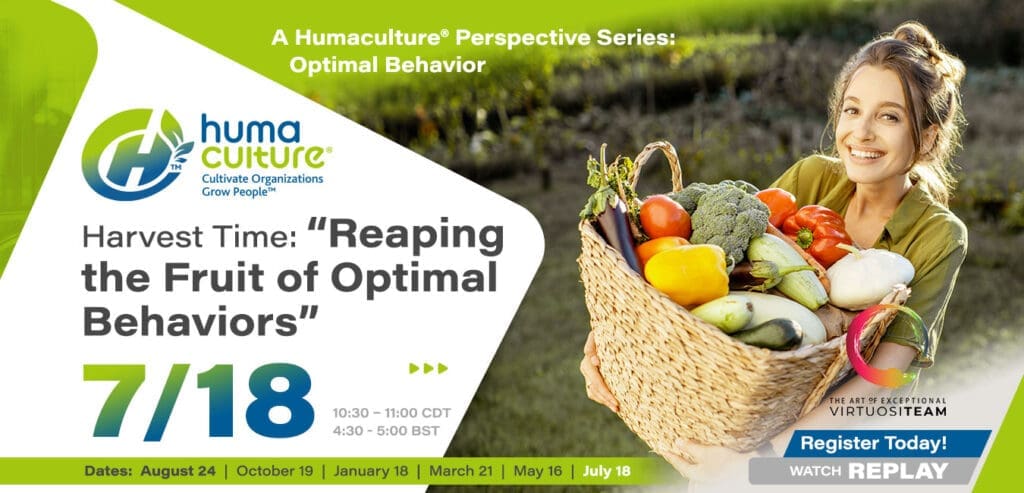
Available Support
We are available to support you in your strategy, design, compliance, financial, and monitoring needs. Our team includes business and human relations leaders, finance experts, actuaries, clinicians, behavioral health experts, pharmacy experts, and legal resources to guide you through the strategy and compliance process. Please contact us: [email protected].
Harvest Time: “Reaping the Fruit of Optimal Behaviors”
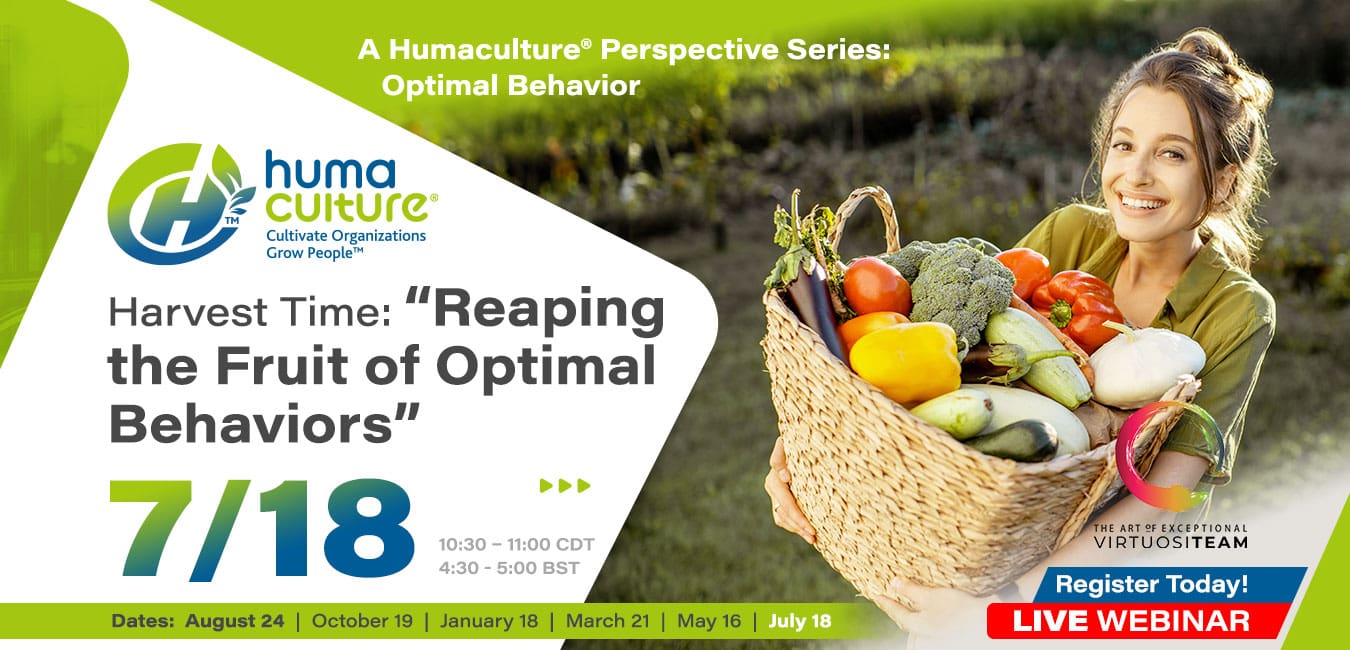
Join us on Thursday, July 18, 2024 from 10:30 to 11:00 CDT (4:30 to 5:00 BST) for the sixth webinar in Humaculture, Inc.’s “Optimal Behavior: Making Optimal Behavior the Natural Choice.” You will learn why and how to apply the four Contexts and four Powers of behavior change through a review of a case example.
Presenters
- Steve Cyboran, ASA, MAAA, FCA, CEBS, actuary and strategy consultant
- Wes Rogers, Humaculturist® and strategy consultant
- Colin Bullen, ASA, behavior change actuary
- Hanlie van Wyk, behavior change consultant
Objective
In this sixth and final session in our series on Optimal Behavior, we explore how to apply all the learning from the previous five webinars to reap a bountiful harvest produced by desired behaviors. To reliably achieve sustained Optimal Behavior, we consider all four Contexts – Spaces, Self, Systems, and Social. We do this by applying the Four Powers – the Powers to grow capability, inspire motivation, overcome barriers, and resist temptation – to align the influences acting on People toward supporting the change to Optimal Behavior. We will demonstrate the process of adjusting the Powers within the Contexts and the practical steps to take using a case study in the retail sector. We wrap up with the virtuous cycle that is the Change Ecosystem, showing how to reinforce Optimal Behaviors and ensure those behaviors stick. At the end of this webinar, attendees will understand how the Powers and Contexts come together to create the Four Powers behavior change framework and how that framework can be applied in practice.
“In the final analysis, change sticks when it becomes the way we do things around here.” – John P Kotter
Harvest Time Key Takeaways
Join us to learn how to apply the Four Powers model of change to reap the following fruits:
- Confident and capable People
- Inspired workplace
- Agile workforce
- People armored against distractions
Available Support
We are available to support you in your strategy, design, compliance, financial, and monitoring needs. Our team includes business and human relations leaders, finance experts, actuaries, clinicians, behavioral health experts, pharmacy experts, and legal resources to guide you through the strategy and compliance process. Please contact us: [email protected].
Webinar Replay: Context of the Self: “The Complexity of Each Person”
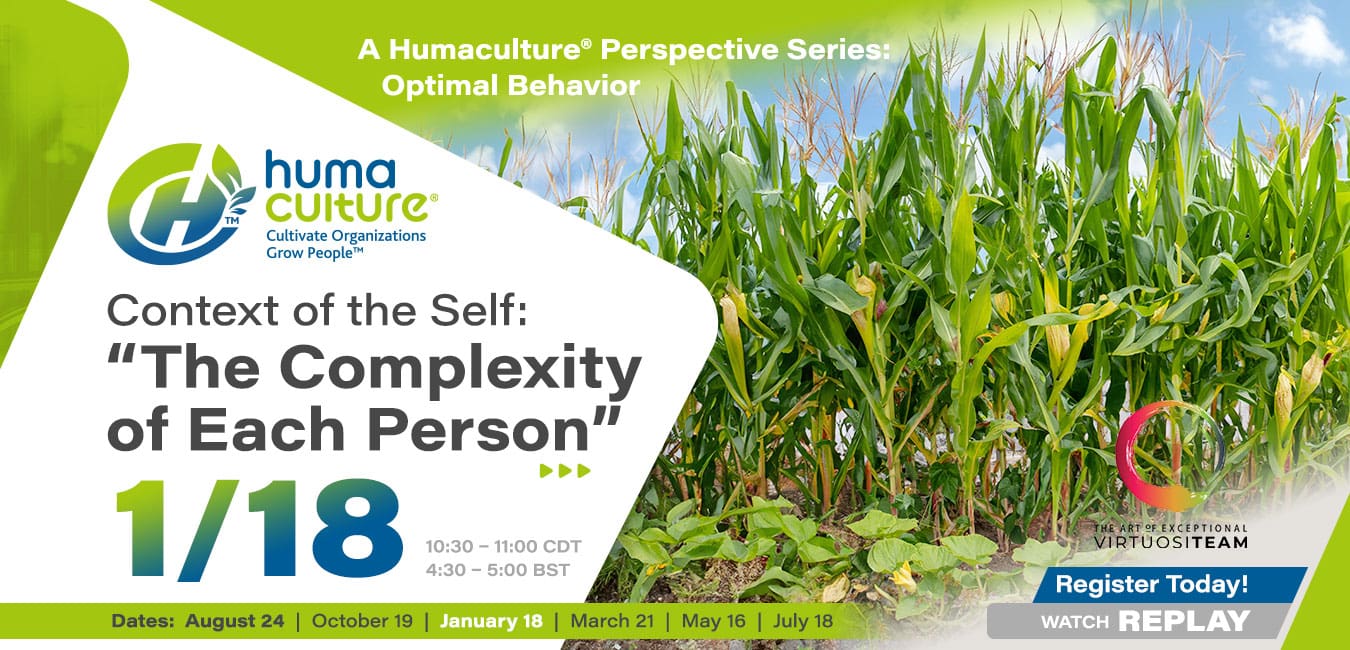
Watch a replay of the third webinar in Humaculture, Inc.’s “Optimal Behavior: Making Optimal Behavior the Natural Choice” to learn why the self can hamper performance and well-being and how to help People to grow capabilities, inspire motivation, overcome barriers, and resist temptations in order to lead to optimal behavior.
Presenters
- Steve Cyboran, ASA, MAAA, FCA, CEBS, actuary and strategy consultant
- Wes Rogers, Humaculturist® and strategy consultant
- Colin Bullen, ASA, behavior change actuary
- Hanlie van Wyk, behavior change consultant
Objective
In this third session in our series on optimal behavior, we explore how the Context of Self influences behavior. To be effective within the Organization, People need to know and manage themselves through their own narrative and understand the same for the People around them. Organizations fail to use narrative stories to connect People to the meaning of changes they are trying to make. Organizations shy away from giving People constructive feedback, yet People need feedback to Grow. Organizations fail to articulate the reason the Organization exists and how People connect with it. To inspire people to perform, Organizational purpose needs to be clear and create emotional attachment, driving motivation. Finally, Organizations associate fun as something that happens outside the workplace and having fun is regarded as unproductive. However, scientists have discovered that it takes approximately 400 repetitions to create a new synapse in the brain, unless it is done in play, in which case it only takes 10 to 20 repetitions.
“The measure of intelligence is the ability to change.” Albert Einstein
Context of Self to Promote Optimal Behavior Key Takeaways
Join us to learn:
- How ineffective organizations:
- Don’t understand how People change behavior
- Don’t Grow Capability and Confidence to change
- Don’t motivate and inspire change
- Don’t recognize how People inhibit sustained behavior change
- How effective organizations:
- Grow competence in change resilience
- Inspire and motivate
- Deploy change sustaining reinforcement tools
Available Support
We are available to support you in your strategy, design, compliance, financial, and monitoring needs. Our team includes business and human relations leaders, finance experts, actuaries, clinicians, behavioral health experts, pharmacy experts, and legal resources to guide you through the strategy and compliance process. Please contact us: [email protected].
Watch
Watch the Career Planning: Effective Pruning Bears Fruit: Manager Development Webinar Replay via Rumble or YouTube.
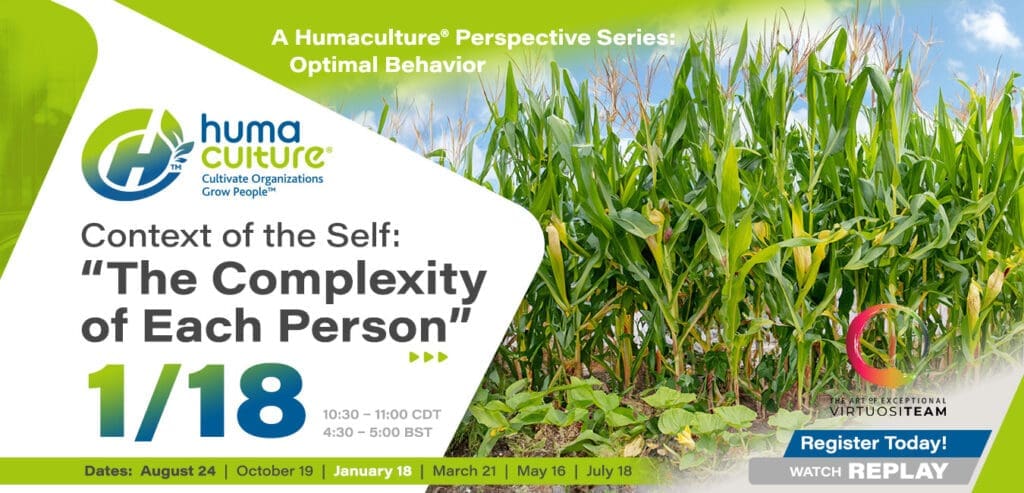
Webinar Replay: Spaces Context: “Grow a Willow in a Desert? The importance of Spaces”

Watch a replay of the second webinar in Humaculture, Inc.’s “Optimal Behavior: Making Optimal Behavior the Natural Choice” to learn why spaces can hamper performance and well-being and how to design your spaces to lead to optimal behavior.
Presenters
- Steve Cyboran, ASA, MAAA, FCA, CEBS, actuary and strategy consultant
- Wes Rogers, Humaculturist® and strategy consultant
- Colin Bullen, ASA, behavior change actuary
- Hanlie van Wyk, behavior change consultant
Objective
In this second session in our series on optimal behavior, we explore how spaces influence behavior. The physical space in which you work can elicit mental and physical reactions that impact positively on performance, mental wellbeing and physical health. Today, physical configuration of buildings reflects a bias toward human energy conservation—and against physical activity, thereby contributing to sedentary behavior which has been linked to nearly all costly lifestyle diseases. In addition, the World Health Organization (WHO) estimates that 30% of new or remodeled office buildings show signs of Sick Building Syndrome (SBS) and that between 10% and 30% of the occupants of these buildings are affected by SBS, e.g. lethargy.
Research further indicates that your physical space can have a positive effect of up to 22% on a range of performance indicators, such as improved concentration, focus, collaboration, learning and cognitive control (working memory, inhibition, and cognitive flexibility). Furthermore, loyalty to an organization is increasingly determined by social and place attachment.
“We shape our buildings, and afterwards, our buildings shape us.” –Winston Churchill
Shaping Spaces to Promote Optimal Behavior Key Takeaways
Join us to learn:
- Why spaces do not support well-being and may lead to sickness
- Why spaces hamper performance
- Why spaces are built counter to tasks
- How effective spaces can be designed to:
- Support healthy behavior and choices
- Improve innovation and performance
- Support efficient task completion
Available Support
We are available to support you in your strategy, design, compliance, financial, and monitoring needs. Our team includes business and human relations leaders, finance experts, actuaries, clinicians, behavioral health experts, pharmacy experts, and legal resources to guide you through the strategy and compliance process. Please contact us: [email protected].
Watch
Watch the Optimal Behavior: Spaces Context: “Grow a Willow in a Desert? The importance of Spaces” via Rumble or YouTube.
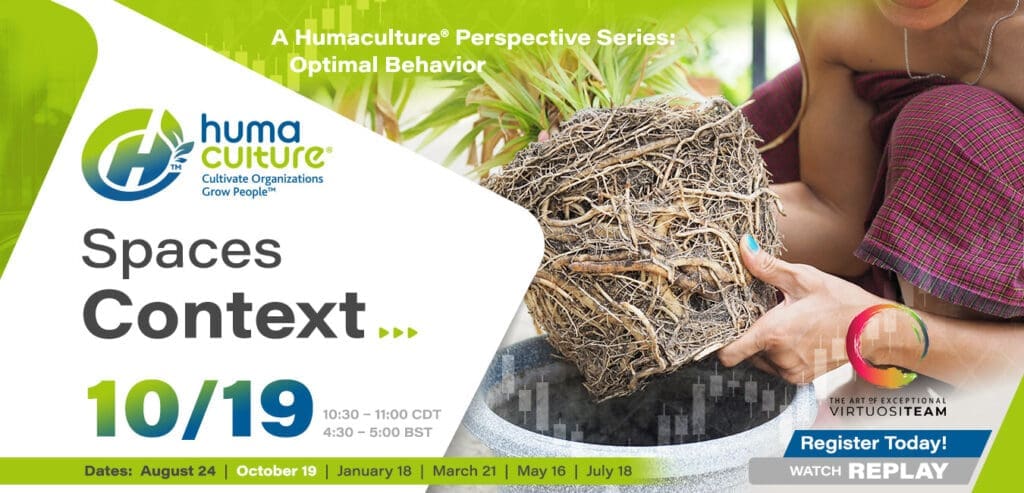
Webinar Replay: Creating the Conditions for Optimal Behavior
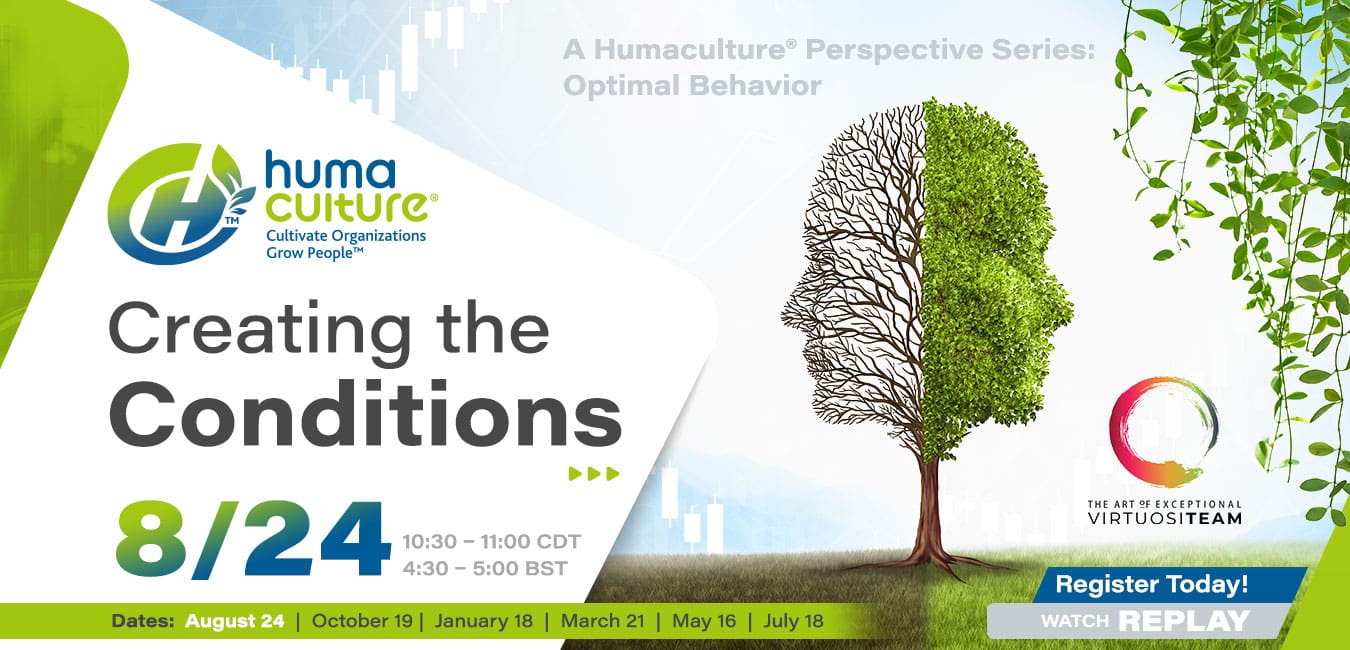
Watch a replay of the first webinar in Humaculture, Inc.’s “Optimal Behavior: Making Optimal Behavior the Natural Choice” to learn why organizations don’t effectively execute change and be introduced to some of the concepts that facilitate optimal behaviors to support a high-performing culture.
Presenters
- Steve Cyboran, ASA, MAAA, FCA, CEBS, actuary and strategy consultant
- Wes Rogers, Humaculturist® and strategy consultant
- Colin Bullen, ASA, behavior change actuary
- Hanlie van Wyk, behavior change consultant
Objective
This is the introductory webinar in our new series on optimal behavior. We explore why people have difficulty in achieving and sustaining change, the difference between short term changes in behavior and long term change through habits, what it takes to achieve optimal behavior in a population, and how to use influence to create a high-performing culture.
Creating the Conditions for Optimal Behavior Key Takeaways
During this session, participants will learn that:
- Why people find it hard to behave optimally
- Why people behave inconsistently
- Why organizations fail to execute change effectively
- How effective organizations:
- Set the contexts to influence behavior
- Understand the powers that influence behavior
- Use influence to create a high-performing culture
Available Support
We are available to support you in your strategy, design, compliance, financial, and monitoring needs. Our team includes business and human relations leaders, finance experts, actuaries, clinicians, behavioral health experts, pharmacy experts, and legal resources to guide you through the strategy and compliance process. Please contact us: [email protected].
Watch
Watch the Career Planning: Effective Pruning Bears Fruit: Manager Development Webinar Replay via Rumble or YouTube.
